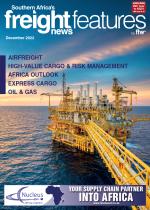Ongoing investment in infrastructure development to support economic growth and global trade, along with growing regional cooperation between African countries to promote common trade policies, will bolster demand for reliable and seamless logistics solutions from the world into Africa.According to Jade Da Costa, Africa CEO of Aero Africa, an overall increase in demand is already evident.With this in mind, the company has invested heavily in its new regional office in Nairobi, Kenya, which is strategically located at the Jomo Kenyatta International Airport.“It positions us to serve our customer better – with neutral airfreight import consolidations from the world to East Africa,” says Absolom Ngari, general manager for East Africa. “This office looks after the group’s interests in the region, operating as a control tower and centralised service centre in East Africa for our overseas partners and clients. It also focuses on promoting our digital airfreight portal, developing blocked space agreements (BSA) scheduled consolidations from the USA, Asia and Europe to East Africa.According to Da Costa, Africa offers the highest return on investment of any emerging market at present. “This is due to several reasons: competition is less fierce, there are few foreign companies present, and consumer demand is strong.”He says with the African continent's accelerated economic growth, and the corresponding increase in logistics activities from direct trade with the Far East and the rest of the world, it has become critical to provide the logistics and aviation sectors with a tailor-made, simplified neutral air cargo solution, supported by a secure financial transacting platform through which to conduct air cargo business with Africa.“Companies are looking for high visibility of their supply chains – and the reduction of parties not only gives them control over the process, but increases the visibility of the procurement process all the way to delivery. It is about end-to-end solutions,” he explains.According to Ngari, there are several positive developments on the continent – including the modernisation of airports, seaports and airlines among others.Airline investments a top priority“African airline investments are a top priority, with Ethiopian Airlines and Astral Aviation topping the list. We are also seeing regional integration efforts, and harmonisation/reduction of cross-border tariffs and barriers, resulting in predictable trade environments.”Da Costa agrees, saying market liberalisation efforts and initiatives to reduce trade imbalances between countries have to be commended.“In this environment, relationships are crucial. The focus is on people rather than the actual transaction on the table. Having a good network of the right partners is an asset to any business, especially in the supply chain.”The airfreight sector, however, is not without challenges. “Global supply chain constraints and interruptions, for example, the loss of capacity due to the war in Ukraine, continue to impact local operations,” says Da Costa. “Economic uncertainties have a substantial impact on demand for air cargo, and foreign exchange is still problematic.”Despite the ongoing investment in infrastructure, it still does pose some challenges in several African countries, resulting in increased costs.Fluctuating fuel prices a concern“Cross-border limitations due to tariffs and other political factors or diplomatic differences can also play a role,” says Ngari. “Of course, global fuel price f luctuations, which impact on operating profits of the operation and market airfreight rates continue to be a concern.”Despite the challenges, Africa’s airfreight and logistics market is in expansion mode as it emerges from the pandemic, and it is attracting significant investment.According to the 2021 Airbus Global Market Forecast (GMF), the projected growth in the continent’s economy will push up air traffic to achieve a full recovery to 2019 levels between late 2023 and early 2025. The strong recovery is attributed to “the fundamental drivers of traffic demand remaining unchanged: economic growth faster than the world average, young and growing population, urbanisation, and middle-class development”

